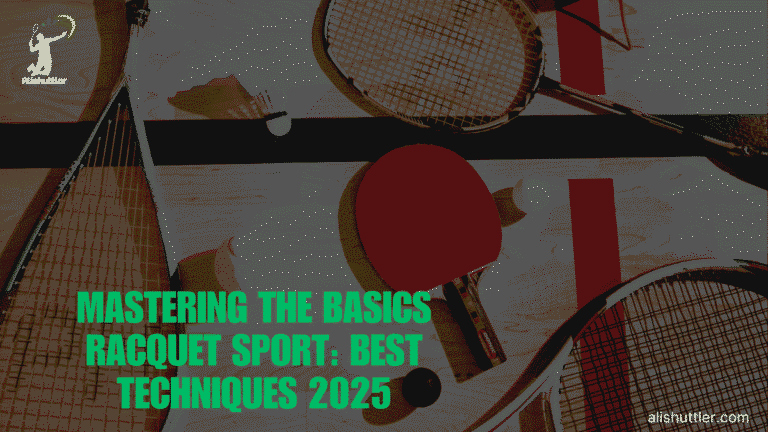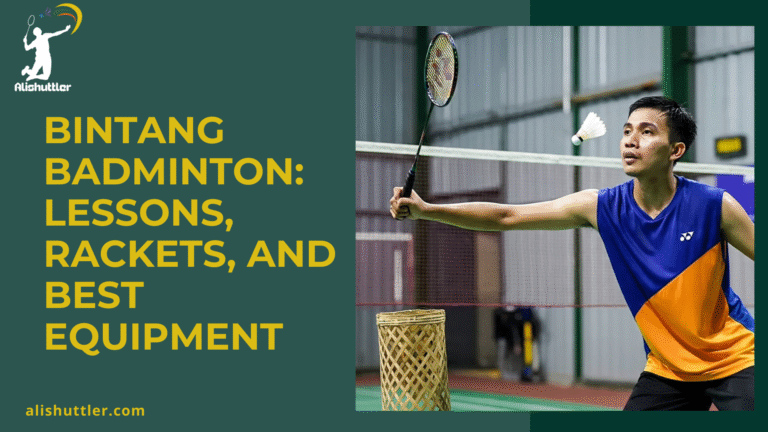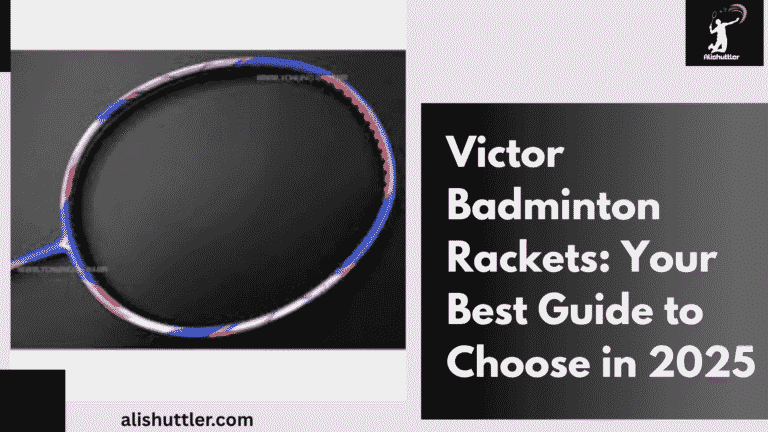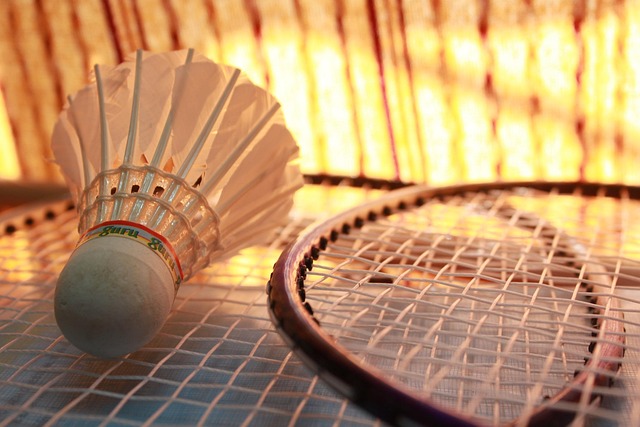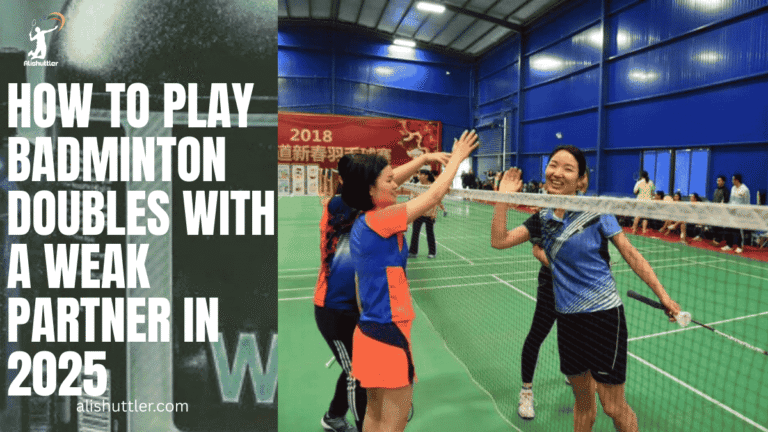Using Your Finger in Badminton helps control the racket and fine-tune shots. Most players utilize their fingers for grip changes, quick flicks, and fast net play.
Finger action can make smashes sharper and lifts more quick. It makes a huge difference in net kill, or deceptive pushes. Knowing how your fingers impart pace and control aids in both defense and offense.
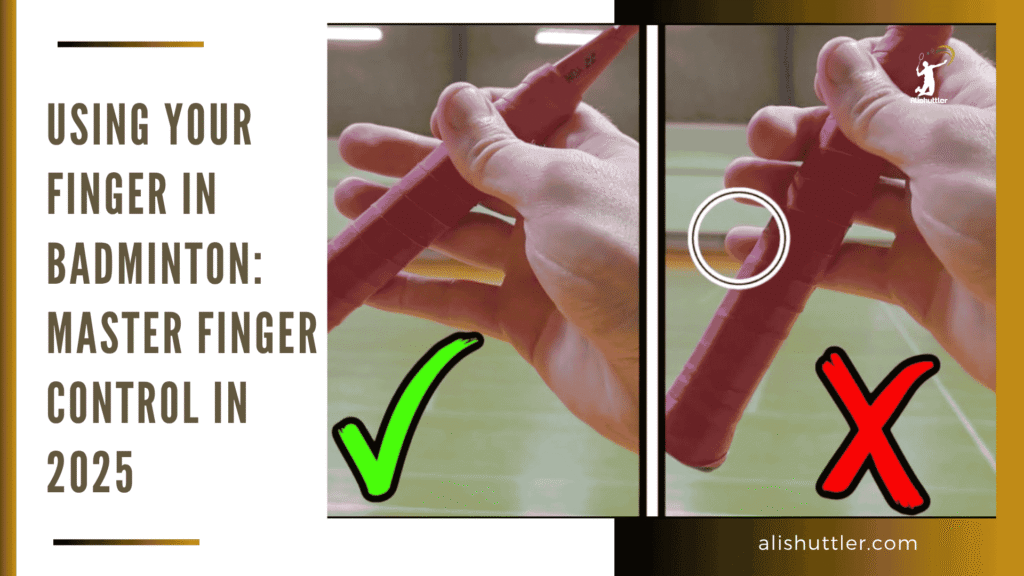
The next sections dissect finger techniques further.
The Finger’s Role
Fingers, it turns out, play a quiet but essential role in badminton, influencing racquet technique, shot placement, and hand protection during fierce rallies. Although arm and wrist maneuvers are readily observable, the fine finger control crucial for developing the correct grip and advancing players is frequently ignored.
Beyond The Palm
Fingers stabilize the racket, allowing players to control each shot. While the palm primarily assists the grip, the fingers drive rapid racket placement and grip style switches—particularly when transitioning from fore- to backhand. Finger motion is more fine-tuned and reactive than the palm-waving gesture.
Mobile fingers enable a large variety of strokes. For example, in a backhand clear, finger action aids in driving the shuttle over the court. Turning the racket in your hand during finger placement drills develops muscle memory and racket feel, providing superior shot versatility and control.
Power Generation
Finger strength is what provides the pop and pace, particularly in quick exchanges. When you’re going back, finger action can increase the power of the shot, not just the arm. This is obvious in various smash types. A half smash depends more on the finger push than full arm swing; finger power is applied for speed and for angle.
By trial and error, she discovered that she could use her finger positions to maximize where the racket strikes the shuttlecock. By incorporating a finger grip-focused routine like stress ball squeezes into your schedule, finger power can become a consistent aspect of your training, making every shot crisper and more controlled.
Shot Deception
Experienced players employ finger tricks to hide their next action. Otherwise, by switching their grip with a subtle finger twist, they can mask the shot’s trajectory or velocity. This helps when faking a drop shot or tweaking a clear at the last second.
Fast finger switches provide for fast switces, keeping your adversaries on their toes. Working on p finger movements increases the dexterity and assists in playing crafty strokes. Here is a comparison of finger techniques used for deception:
| Technique | Movement Type | Shot Example | Effect |
|---|---|---|---|
| Finger Push | Sudden snap forward | Half smash | Increases speed, angle |
| Finger Roll | Rolling fingers | Slice drop | Changes shuttle path |
| Finger Twist | Quick twist motion | Backhand flick | Hides true shot direction |
Injury Prevention
To prevent injuries, warm up fingers with stretches and gentle squeezing drills. Practice gripping exercises to boost finger strength. Rotate the racket gently to improve grip switching. Use stress balls or rubber bands for resistance training.
Maintain a relaxed hold to minimize stress, and catch pain or fatigue like pain and fatigue early. Tweak finger actions to prevent overuse. Stretch and warm up before play finger stretches and gentle flexing.
Mastering Finger Control
Finger control is a fundamental skill for badminton players who desire crisp, precise shots. Every top spin clear or smash or drop ultimately boils down to how well you control the racket with your fingers. Fine finger work assists grip strength, shot angle, and even quick grip changes during rallies.
With consistent training, players develop the finger strength required to transition from simple strokes to crafty, deceptive shots.
1. The Forehand Grip
The proper forehand grip lays the foundation for powerful control-oriented swings. Begin by gripping the racket just as you were going to shake hands with it, ensuring the thumb and forefinger create a V-shape on the handle. This shape provides the most control on forehand shots.
Finger placement is crucial. Keep the fingers ‘open’ across the handle, not jammed together. This spread assists you in guiding the racket face and altering racket angles mid-swing.
When smashing fast clears or subtle net pushes, vary your grip pressure. For a smash, squeeze a little tighter for muscle, but for a net shot, ease up. Having the ability to toggle grip pressure and move between grips rapidly indicates proficient finger skills.
Work switching grips during rallies or shadow swings. This develops the finger agility required in actual matches.
2. The Backhand Grip
The backhand grip is a bit different. Keep the thumb flat on the back of the handle; it provides additional push and control for backhand drives and lifts. This grip employs the thumb for stability, but depends on the other fingers to steer and stabilize the racket.
Experiment with slight variations in finger positioning to find what suits your style. Some players utilize more of their index finger, while others use more of their thumb. Finger control on backhands is slow to pick up, but it increases shot precision and allows you to easily manage backhand drops, clears, or net shots.
Transitioning from forehand to backhand grip requires speedy finger action. The quicker your fingers can swivel the racket, the less time your opponent has to respond.
3. Net Play Finesse
Excellent finger control is the secret to net play. Delicate net shots drops or net kills utilize subtle finger movement. A tight grip can make shots stiff, while a loose grip gives more touch and feel.
For drills, tap the shuttle gently at the net or use fingertip taps to roll the shuttle over the tape. Fast hands at the net are the result of consistent finger workouts.
Just wall drills, or a partner feeding shuttles to your forehand and backhand, emphasizing light, quick finger motions. Under pressure, finger control helps add deception–making the opponent guess if you’ll drop, push, or flick the shuttle.
4. The Smash
Powerful fingers give each smash extra speed and angle. Snap that racket at the contact point with your last three fingers — pinky and all. The pinky is difficult for some players to control, but additional training can assist.
Finger power provides the smash with its punch, but finger timing counts as well. Snap drills and half smashes teach you how finger grip alters shot speed and angle.
Combine that with grip-strength drills to develop the muscles required to deliver a solid, crisp smash.
5. The Drop Shot
Drop shots require delicate feel. Mastering finger control lets you drop the shuttle right over the net. Alter grip pressure mid-swing to regulate shuttle velocity.
Finger feel is crucial. Practice soft finger taps to estimate distance. Mix it up too, experimenting with drop shot styles—slow, fast, cross-court—so your opponent can’t predict your next shot.
Advanced Fingerwork
Advanced fingerwork in Using Your Finger in Badminton is all about using fine finger control to alter shuttle movement, emphasizing the importance of grip choice. This savvy allows players to craft every shot, including forehand grip shots and backhand shots, with spin, angle, and velocity. It all depends on your use of different grips and finger placement.
Generating Spin Using Your Finger in Badminton
It takes more than a wrist flick to add spin to a badminton shot. It begins with your racket grip utilizing the ‘V shape’ between your thumb and index finger, leaving a slight gap between your index and middle fingers. This grip allows fingers space to wriggle and curl and whip the racket around rapidly.
Support with your thumb and index finger to poke or pull, allowing you to turn the racket face and impart spin. For instance, an occasional tight net shot with a touch of side spin can cause the shuttle to dip and curve, challenging your opponent’s ability to return it.
Practice comes to the rescue here. Attempt finger movement drills without a shuttle simply rotate the racket using your fingers, not your entire arm. Once you’re comfortable, introduce a shuttle and play slow net shots, paying attention to how your fingers twist the racket.
Pay attention to the way the shuttle spins, observe your opponent’s response. If you put spin on it, the shuttlecock may alter its trajectory, which makes your stroke less consistent. With time, you’ll notice how various spins affect the shuttle’s flight and bounce.
Shot Trajectory
Fingerwork is crucial for varying the height and angle of your shots, especially when utilizing the correct grip. Tiny finger slides can convert a flat drive into a steep drop or a high lift. For practice, switch finger position between shots, such as sliding your index finger up the handle for a higher lift, which is a key aspect of mastering the forehand grip.
Wrist and finger coordination is essential, particularly when executing different shots. Experiment with drills where you play the same shot but to varied angles, using only finger and wrist motion. This builds muscle memory and enhances your racquet technique, keeping you quick to respond in matches Using Your Finger in Badminton.
By changing up your shot angles, you not only keep your opponent guessing, but you also make your game less predictable, showcasing your strengths in racquet play.
Grip Pressure Using Your Finger in Badminton
How you grip the racket affects your control and power, especially when considering the correct grip for different shots. A looser grip is ideal for softies, while a tighter grip is necessary for smashes. Begin with clears using a relaxed hand, then tighten as you hit harder. Pay attention to how grip pressure alters your finger movement if you grip too tight, your fingers can’t move fast to compensate.
Too many players don’t even realize they use the wrong grip for certain shots, so it’s useful to go through the motions of grip changes without a shuttle, smoothly switching between forehand grip shots, backhand shots, bevel, and panhandle grips.
Grip pressure drills build consistency. For instance, experiment by attempting to tap the shuttle with varying grip strengths and observe how that modifies the shot. This practice accustoms you to shifting on the fly and enhances your overall racquet technique.
Finger Conditioning
Using Your Finger in Badminton conditioning is a staple of badminton coaching, as it enhances your grip choice and allows for quick changes in different grips. Power and flexibility in your fingers enable you to hold the racquet firmly with a touch, move with quickness, and execute various shots effectively. This solid finger power can impart control and give your smash a lift, preventing injuries and improving performance.
Dexterity Drills
Finger conditioning drills force your Using Your Finger in Badminton to move quick and slick. Use drills, such as picking up small objects or rolling a pen between your fingers to test your coordination. Fast grip changes on your racquet or tapping finger tips together in patterns. These moves get your hands responding in real time, assisting you in playing quick shots or blocking razor-sharp smashes.
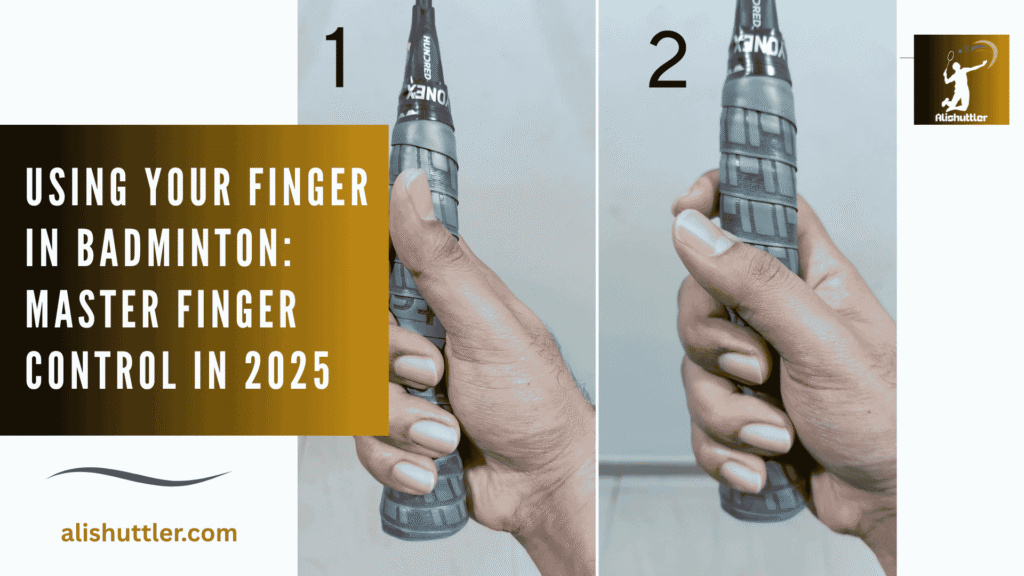
Mix up your instruments. Train with coins, marbles or soft foam balls. Even easy games like snapping your fingers to various rhythms can increase agility. Either time yourself or count the number of reps you can do in a minute. This allows you to visualize whether your fingers are becoming more agile.
Strength Exercises Using Your Finger in Badminton
Using Your Finger in Badminton strength is connected to your racquet grip. It fuels your shots, assists in speedy flicks, and allows you to switch grips mid-rally. Employ resistance bands to target finger muscles, extend and retract your hand around the band, or compress a soft ball for grip strength.
Try gripping the racquet with only your pointer and thumb for mini-sessions. This grip, employed by many elite players, assists in developing agility and precision. Incorporate grip strengtheners, aka hand grippers. Squeeze for ten seconds, relax, repeat. This exercises the tiny muscles in your hand and wrist.
Log your grip using a dynamometer, or count how many reps you can bang out with a given weight. Checking your progress every week keeps you focused by helping you set new goals and identify weak areas.
Weekly Finger Conditioning Exercise Routine
- Day 1: Dexterity drills (5–10 min) with coins or marbles
- Day 2: Resistance band finger squeezes (3 sets of 15 reps)
- Day 3: Grip strengthener reps (3 sets, 10 seconds each)
- Day 4: Racquet grip switches (3 sets of 20 switches)
- Day 5: Pen rolling and finger tapping (5 min each)
- Day 6: Two-finger racquet holds (3 sets, 15 seconds each)
- Day 7: Rest or review progress
The Sensory Connection
That sensory connection between your fingers and the badminton racket forms how you direct each shot. This connection allows you to sense the nuanced response of the shuttle, racket strings, and grip pressure. The brain decodes multisensory cues from the court sound, sight, and feel to accelerate reaction times and direct every move.
Various strings and racket styles shift the feel of feedback, so rotating equipment helps you understand the boundaries and power of your stroke. We tend to study multisensory processing in labs, but these same principles emerge in badminton any time you make a nanosecond adjustment based on what you hear and see and feel.
- Concentrate on the sensation of the shuttlecock striking the string bed.
- Listen to the variations in the sound between soft drop shots and hard smashes.
- Observe the grip pressure in different rallies.
- Close your eyes, and try to catch the shuttle blindly by the ringing alone.
- Adjust string tension and notice how feedback changes.
- Deep breath and fingertip respect.
Intuitive Play Using Your Finger in Badminton
To intuit means to play Using Your Finger in Badminton by letting your fingers wander about so your body responds without thinking. This talent develops from establishing muscle memory via drills, but from learning to believe the subtle signs you receive from your hand and racket.
Most elite players are making these finger adjustments during rallies; they just don’t realize it. These changes allow them to react quickly to erratic shots. Watching slow-motion replays, you can observe fingers curling and shifting to direct the racket head.
If you deconstruct a winning rally, you’ll catch them in action, a quick wrist flick for a net kill or subtle grip adjustment for a defensive block. If nothing else, practice improvising finger movements during friendly matches.
Organize drills in which you have to respond to random shuttle placements, using nothing but finger tweaks to modify your racket angle. This trains your fingers to “read” what’s required without thinking.
Reading The Shuttle
Quick reflexes in badminton rely on anticipating the shuttle’s velocity and rotation, which is crucial for executing backhand shots effectively. Training your fingers for speed involves timing drills that can be enhanced by using different grips. For instance, multi-shuttle drills with varying speeds compel immediate finger modifications and improve grip choice, allowing players to adjust their racket technique as needed.
Turns out, multisensory cues like seeing and hearing the shuttle help the brain work faster. Players respond quicker when they hear the shuttle’s contact, especially during high-intensity rallies. Coaches will occasionally throw in auditory cues to train anticipation, allowing players to concentrate on both vision and hearing while maintaining the correct grip. Using Your Finger in Badminton.
Using Your Finger in Badminton instinct develops with directed training, especially when focusing on different thumb positions. Experimenting with basic wall rallies or shadow swings emphasizes rapid, gentle contact, which helps players refine their forehand grip and backhand drive techniques. Over time, your brain associates these small signals with quicker responses, helping you stay ahead of quick rallies.
Coaching Philosophies
| Coaching Approach | Finger Technique Focus | Training Methods |
|---|---|---|
| Traditional | Emphasizes wrist, less on fingers | Basic grip drills, standard rallies |
| Modern | Strong finger emphasis | Isolated finger exercises, reaction drills |
| Analytical | Data-driven finger use | Video review, sensor-based feedback |
Passing on finger training tips to teammates enhances our racquet technique, making us all better. Fine finger control paves the way for advanced strategies like faking shots or net pinning. Working with coaches to review slow-mo footage can identify micro changes for improved performance in playing backhand shots.
Mindfulness Practices Using Your Finger in Badminton
- Breathe slow and notice finger tension
- Do short meditations before matches
- Focus on sound and touch during rallies
- Limit distractions for better focus
Rules of Engagement
Using Your Finger in Badminton outlines specific ground rules for what players are allowed to do with their hands and fingers. The fingers are crucial for spin, control, and rapid shot-direction changes, but there are stringent rules. Per official badminton laws, only the racquet can contact the shuttle. If fingers, palm, or any part of the hand other than the racket handle touch the shuttle, it is a fault. This rule keeps the game honest and ensures that skill, not inadvertent hand contact, determines the point.
Grip selection is a huge component of finger utilization, especially when considering the correct grip for different shots. The two most common grips are the forehand grip and backhand grip, both requiring the thumb and index finger for control. The racquet must be held by the handle only. There’s typically a thumb against the side for support and an index finger pointing down the shaft for guidance. If a player grabs the shaft above the handle while playing, this can result in a fault.
Certain players turn to a “Using Your Finger in Badminton power grip to generate additional snap or spin during their shots. That’s OK if the grip remains on the handle and the fingers don’t slide up to the racket head or shaft. Finger skill is permitted, but the rules restrict locations and the type of finger usage. Typical finger-related errors include sliding your hand up the racket mid-rally, poking the shuttle with a finger, or dropping your racket and knocking the shuttle with your hand instead. They all violate the usual rules.
As an illustration, if a player attempts to save a low shot and their fingers graze the shuttle, the umpire will deem it a fault. In elite-level matches, players will occasionally employ split-second finger substitutions to fake or mask shots, but they must always remain within the legal grip zone. BWF reviews the laws of Using Your Finger in Badminton. They don’t change very often, but releases can reclassify how grips are defined or clarify finger usage.
Referees and coaches alike suggest reviewing the most recent BWF rules prior to tournaments, as even minor modifications can impact play. This is particularly true for players who employ fancy finger action on fast net shots, flicks or deceiving. Sticking to the present rules shields players from errors and arguments.
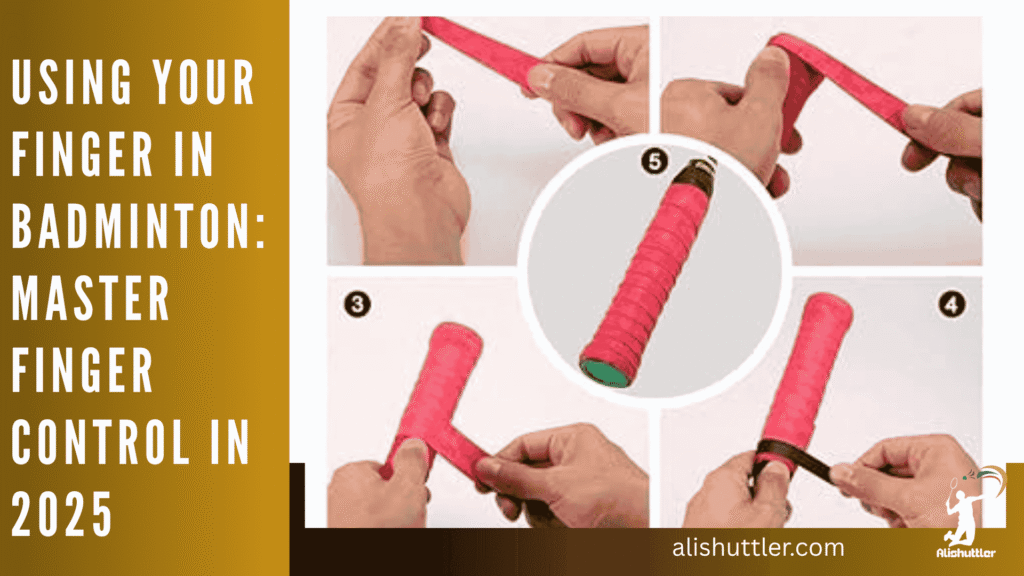
Match format rules set the structure: best-of-three games, change of ends after each game, and at 11 points in the third game. Must win by 2 clear points if the score reaches 20-20, but at 29-29, first to 30 wins. A point is scored solely if the shuttle drops in the opposite half, lines and all. Correct hand and finger positioning satisfies these rules at each point, ensuring players can perform their best on the court.
Final Thoughts on Using Your Finger in Badminton
Finger work molds your badminton. Fast shots, snap shots and delicate shots all emanate from powerful fingers. Little adjustments can transform a languid smash into a cannon shot or effortlessly direct a shuttle. Players who develop finger technique demonstrate greater control on the court. With practice your grip feels more confident and shots fall where you intend.
Good finger care prevents injury and maintains hands strong for every game! Stay on top of drills and be conscious of finger movements. To improve your game, experiment with new finger drills and vet tips you stumble across. Discuss what works for you or seek advice from others. Small steps make up progress, so don’t stop.
Frequently Asked Questions
What is the role of fingers in badminton?
Your fingers manage the racquet grip and lead, assisting in producing fast moves, accurate shots, and powerful smashes, emphasizing the importance of correct grip choice for beginners.
How can I improve my finger control in badminton?
Practice racket finger drills like tapping the shuttle or quick grip changes to enhance your forehand grip and backhand shots. Daily practice develops superior coordination and quicker reflexes.
Are there specific drills for advanced fingerwork?
Yea, why not shuttlecock juggling, quick grip switches, or wall rallies? These drills enhance your racquet technique, building quickness, accuracy, and flexibility in your fingers.
Why is finger conditioning important for badminton players?
Good, pliable fingers diminish fatigue and injury potential, allowing for better grip choice and enhancing shot precision in extended matches.
How do fingers help with sensory feedback in badminton?
Fingers feel whispers of vibrations and shuttle contact, enhancing shot control and grip choice for different shots like forehand grip shots and backhand shots.
Are there any rules about using fingers in badminton?
Badminton rules permit finger involvement to hold and manipulate the racquet exclusively, emphasizing the importance of grip choice for playing backhand shots.
Can finger strength affect my badminton performance?
Yup, powerful fingers provide grip stability and enhance precision, which are crucial for executing different shots effectively.

